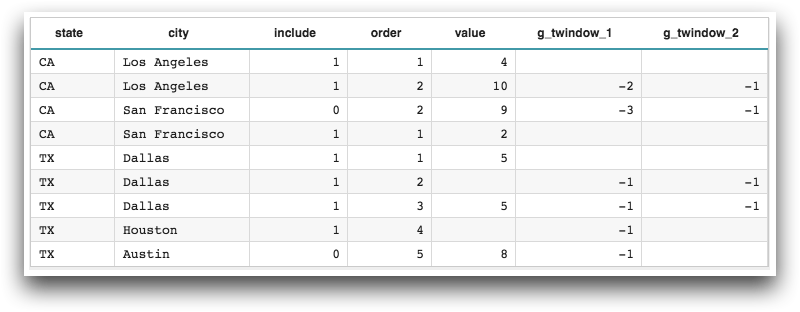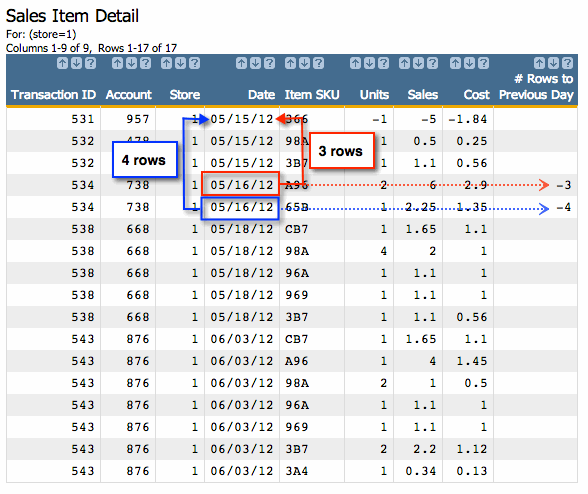g_twindow(G;S;T;TS;N)
Returns the number of rows to the row that is exactly a certain time period before (or after) the current row within a given group.
Function type
Vector only
Syntax
g_twindow(G;S;T;TS;N)
t_twindow(N)Input
| Argument | Type | Description |
|---|---|---|
G |
any | A space- or comma-separated list of column names Rows are in the same group
if their values for all of the columns listed in If If any of the columns listed in |
S |
integer | The name of a column in which every row evaluates to a 1 or 0, which determines
whether or not that row is selected to be included in the calculation If
If any of the values in
|
T |
integer or decimal | The name of a column whose values are used as the basis of the time
series Row order is determined by Note:
T may not be omitted. |
TS |
text | A string representing the type of the time TThe choice of
Valid types are:
If |
N |
|
The number of rows to shift within the group |
Return Value
G and ordered by T
(and for those rows where S=1, if specified):- If
N>= 0:-
g_twindowreturns the number of rows from the current row to the row that is exactlyNtime periods after this row in the same group as this row.If there are multiple rows that are exactly
Ntime periods after this row,g_twindowreturns the number of rows to the first row within that set of rows. -
If there are no rows that are exactly
Ntime periods after this row,g_twindowreturns N/A.
-
- If
N< 0:-
g_twindowreturns the number of rows from the current row to the row that is exactly |N| time periods before this row in the same group as this row.If there are multiple rows that are exactly |
N| time periods before this row,g_twindowreturns the number of rows to the first row within that set of rows. -
If there are no rows that are exactly |
N| time periods before this row,g_twindowreturns N/A.
-
Time periods are determined by TS with respect to the
values in T.
The result is the same data type as X.
X are treated like any other value; i.e. they are
shifted.If no rows in a group have valid (non-N/A) values for X, the result for
every row of the group is N/A.
Sample Usage
<base table="pub.doc.samples.ref.func.g_func_time_series_sample_usage"/> <willbe name="g_twindow_1" value="g_twindow(state;include;order;;-1)"/> <willbe name="g_twindow_2" value="g_twindow(state city;include;order;;-1)"/>

Example
For this example, we'll use the sales data available in pub.demo.retail.item, which contains sales transactions from three stores.
Let's say we want to find out the number of rows from the current row to the previous day.
To do this, we can use g_twindow.
<sel>
operation to pare down the data:
<sel value="(store=1)"/>Now our table just shows the transactions from store 1:

The g_twindow function has the form:
g_twindow(G;S;T;TS;N)Since we already selected the rows for store 1, which is
the group we're interested in, we can omit the G parameter. (If we hadn't
done the <sel> operation earlier, we could have set G
to store here in order to group the results by store.)
We can also omit the S parameter, since we want to consider all rows when
applying the function.
We'll use the date column for our
T parameter and set the TS parameter to
'D' (since the data in the date column is of the
date type), and we'll set the N parameter to
-1, which will allow us to shift back to the previous day in our
table.
g_twindow function should look
like:g_twindow(;;date;'D';-1)G and S parameters, we still need to account for them
in the function call; hence, the ";;" before
date.g_twindow function
using <willbe>:
<willbe name="rows_to_previous_day" label="# Rows to`Previous Day" value="g_twindow(;;date;'D';-1)"/>The results of this operation will look like:

Notice all the N/A values in our new column. That's because
the only data we have for consecutive days is on 05/15/12 and 05/16/12, and
g_twindow only returns a non-N/A result when there is an exact match with
respect to the time period specified. So, for each row with the date 05/16/12,
g_twindow returns the number of rows to the previous day, 05/15/12.
g_twindow
returns the number of rows to the first row with that date.So, in our example, for the first transaction with the date 05/16/12,
g_twindow returns a -3, meaning that you
need to shift back 3 rows in the table to get to the previous day. For the second
transaction with the date 05/16/12, g_twindow returns a
-4, meaning that you need to shift back 4 rows in the table
to get to the previous day.
All the other transactions are more than one day apart;
therefore, g_twindow returns N/A because there is no exact match with
respect to the time period specified.
If you wanted to find the nearest row whether there was an exact match or not with respect
to the time period specified, you could use g_twindow_nearest.
Additional Information
- The
t_version of this function defaults theGandT/TSarguments, and omits theSargument. The defaults forGandT/TSare set at table load time based on the organization of the table.
